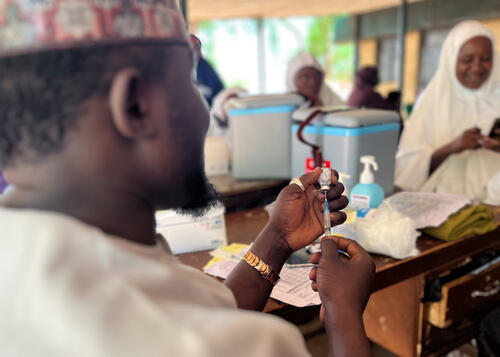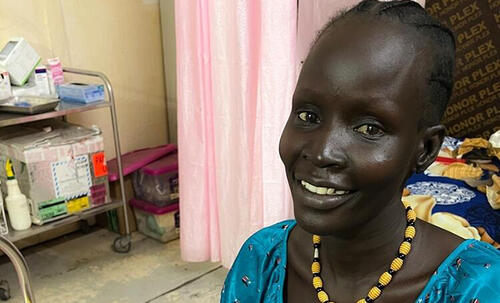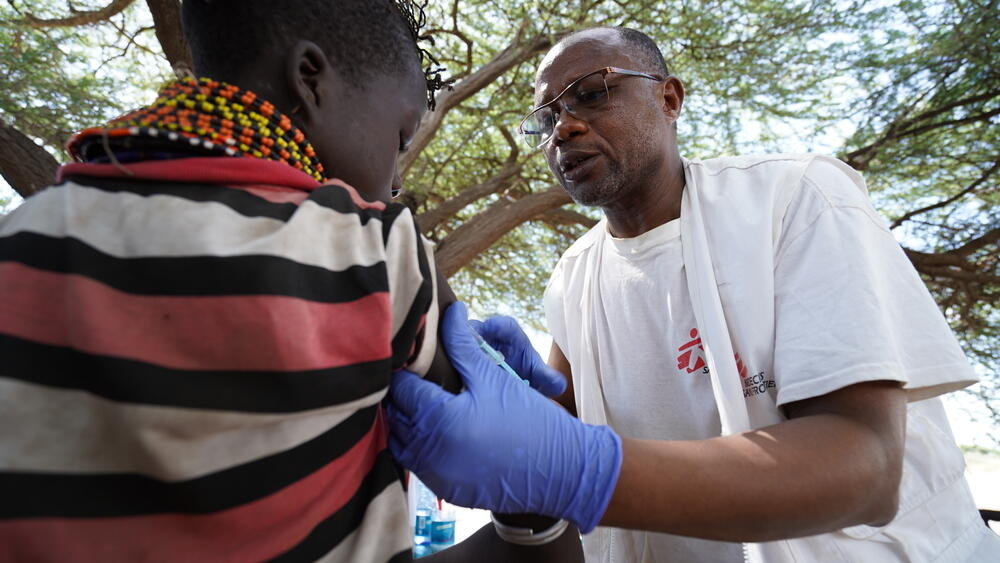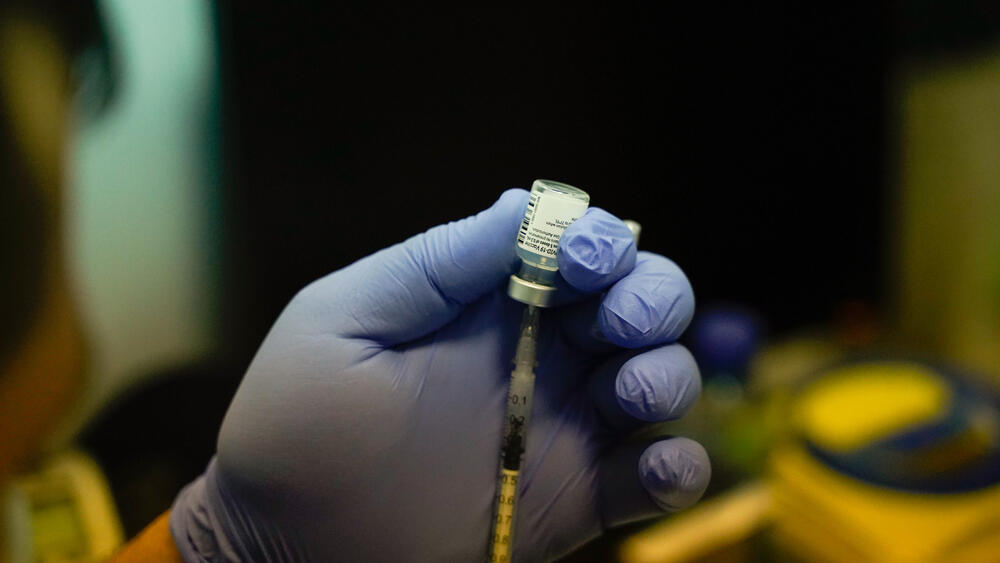Vaccines
Vaccines are among the most effective medical tools to protect people worldwide from dangerous infectious diseases. They save millions of lives every year and help to contain epidemics.
Despite their success, there are still major challenges in providing vaccines, especially in conflict and crisis zones.
Médecins Sans Frontières / Doctors Without Borders (MSF) teams around the world work to ensure that people in humanitarian emergencies have access to life-saving vaccinations.
Vaccines: key facts
14.5 MILLION
CHILDREN MISSING OUT ON ANY VACCINATION GLOBALLY IN 2023
3,295,700
VACCINATIONS AGAINST MEASLES IN RESPONSE TO AN OUTBREAK ADMINISTERED BY MSF IN 2023
4,623,714
ROUTINE VACCINATIONS ADMINISTERED BY MSF IN 2023
The importance of vaccines
According to the World Health Organization (WHO), vaccines prevent 3.5 to 5 million deaths every year from diseases such as diphtheria, tetanus, pertussis, influenza, and measles.
Vaccines are particularly vital in regions with limited access to medical care. They help prevent epidemics and reduce the burden on fragile health systems.
The COVID-19 pandemic severely disrupted health services in many areas. Vaccine production and delivery were affected, and millions of children missed routine vaccinations. Since 2020, this has created alarming immunity gaps, especially in vulnerable communities.
In conflict-affected countries like the Democratic Republic of Congo (DRC), vaccination coverage was already low before the pandemic.
In 2023, more than 300,000 measles cases and nearly 6,000 related deaths were reported in DRC (See: Why measles remains a mass killer in DR Congo) - about 50,000 more cases than before the COVID pandemic began. Only 38 percent of children were fully vaccinated in 2023, down from 45 percent in 2022.
An estimated 2 million children in DRC remain unvaccinated against measles.
How do vaccines work in the body?
Vaccines train the immune system to recognise and fight off pathogens without causing the actual disease. They contain weakened or inactivated viruses, or fragments of them, which stimulate the immune system to produce antibodies.
These antibodies, along with memory cells, ensure that the body can mount a fast and effective response when exposed to the real pathogen later. In some cases, this protection can last a lifetime, while in others, booster doses are required.
Vaccines: Latest news and stories



Types of vaccines
There are several types of vaccines, depending on the technology used and the medical objective:
• Live vaccines use a weakened form of the pathogen. They replicate in the body but do not cause illness. Examples include the measles, mumps, and rubella (MMR) vaccine.
• Inactivated vaccines consist of killed pathogens or their components. They often require booster doses for long-term protection. Examples include vaccines for hepatitis B, diphtheria, and tetanus.
• mRNA vaccines contain genetic instructions that prompt the body to produce a specific antigen, triggering an immune response without introducing the pathogen itself. This type became widely known by the general public with vaccines introduced against COVID-19 during the 2020 coronavirus pandemic.
• Vector vaccines use harmless viruses to deliver genetic material into the body, provoking an immune reaction. This includes vaccines for Ebola and some COVID-19 vaccines, such as those by AstraZeneca and Johnson & Johnson.
Myths and facts about vaccines
There are many myths about vaccines that can cause uncertainty. Fortunately, we can counter them with scientifically proven facts:
Myth: Vaccines cause serious side effects
Fact: Vaccines use weakened or inactivated pathogens or their components. They cannot cause the disease. Side-effects like mild fever or soreness are usually short-lived and are signs that the immune system is working. Stronger reactions to vaccines are extremely rare.
Myth: Too many vaccines overwhelm the immune system
Fact: The immune system encounters countless pathogens every day. Vaccines expose it to a controlled amount of antigens, allowing it to develop a specific immune response without stress.
Myth: Natural immunity is better than vaccination
Fact: Infections of non-vaccinated individuals can lead to severe complications or even death. Vaccines offer safe protection without exposing people to those risks.
Vaccine development and safety
Vaccine development is a multi-stage process that can take several years. It includes:
• Preclinical phase: Laboratory tests on cell cultures and animals to assess safety
• Clinical trials: Testing on humans in three phases to evaluate safety and effectiveness
• Authorisation: Regulatory agencies like the European Medicines Agency or the Medicines and Healthcare Products Regulatory Agency assess the data and approve the vaccine
• Post-market surveillance: After approval, vaccines continue to be monitored for side effects and long-term effects
The rapid development of coronavirus vaccines showed that scientific collaboration and investment can accelerate vaccine availability without compromising safety.
However, the pharmaceutical industry often uses patent protection to prioritise profits over access. MSF continues to advocate for equitable vaccine distribution and affordable access for all.
Recommendations: Routine childhood vaccinations
WHO and national health agencies issue vaccination guidelines based on medical and epidemiological data. Routine childhood vaccinations usually include:
• BCG
• Diphtheria, tetanus, pertussis (DTaP)
• Measles, mumps, rubella (MMR)
• Polio
• Hepatitis B (including birth dose)
• Pneumococcal diseases
• Rotavirus
• HPV (human papillomavirus)
• Meningococcal diseases
• Influenza
• Varicella (chickenpox)
• Yellow Fever
• Malaria
Adults are also advised to stay up to date with vaccinations, including annual flu shots, tetanus boosters, and COVID-19 vaccines.
Vaccines and their role in combating diseases
Vaccines have helped control or eliminate many diseases. Smallpox was eradicated globally through vaccination. Polio remains endemic in only a few countries, and measles cases have dropped significantly in areas with high vaccination rates.
Still, vaccination coverage remains dangerously low in many regions. According to the WHO immunisation report of 2024, only 52 percent of people in DRC have received a first dose of the measles vaccine. In Yemen, the figure is just 45 percent. For herd immunity, at least 95 percent coverage is needed.
Vaccine provision in humanitarian crises
In humanitarian crises, vaccines are often the difference between life and death. MSF teams regularly carry out large-scale vaccination campaigns in crisis-affected and conflict areas to prevent and respond to outbreaks.
But access to vaccines is frequently hindered by logistical barriers, fragile supply chains, and restrictions in conflict zones. That is why we advocate for fair, affordable, and equitable global vaccine provision - so that no one is left behind.

